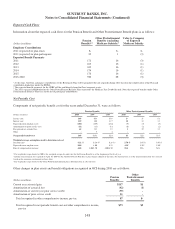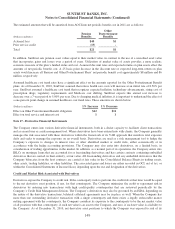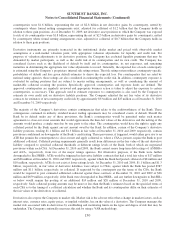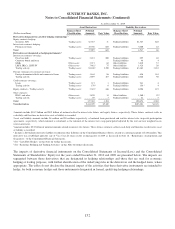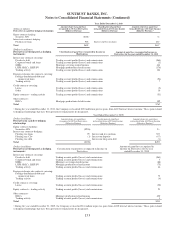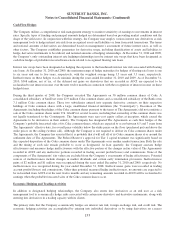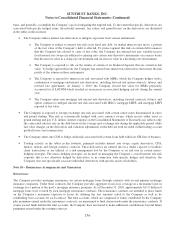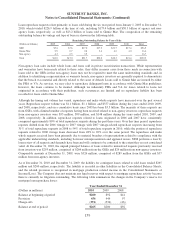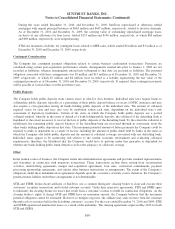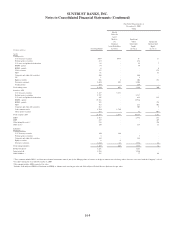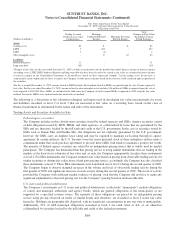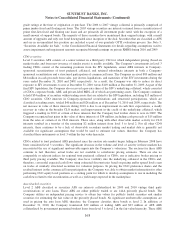SunTrust 2010 Annual Report Download - page 174
Download and view the complete annual report
Please find page 174 of the 2010 SunTrust annual report below. You can navigate through the pages in the report by either clicking on the pages listed below, or by using the keyword search tool below to find specific information within the annual report.
SUNTRUST BANKS, INC.
Notes to Consolidated Financial Statements (Continued)
Conversely, the Company will be compensated by the Counterparty for any increase in the conversion factor. The
Counterparty, as a result of its ownership of the Class B common stock, will be impacted by dilutive adjustments to the
conversion factor of the Class B common stock caused by the Litigation losses. The conversion factor applicable to the
Class B common stock decreased in 2010 and 2009 due to Visa’s deposits into the litigation escrow account, triggering
payments by the Company to the Counterparty of $17 million and $10 million during 2010 and 2009, respectively. A
high degree of subjectivity was used in estimating the fair value of the derivative liability, and the ultimate cost to the
Company could be significantly higher or lower than the $23 million and $40 million recorded as of December 31, 2010
and December 31, 2009, respectively.
Letters of Credit
Letters of credit are conditional commitments issued by the Company generally to guarantee the performance of a client
to a third party in borrowing arrangements, such as CP, bond financing, and similar transactions. The credit risk involved
in issuing letters of credit is essentially the same as that involved in extending loan facilities to clients and may be
reduced by selling participations to third parties. The Company issues letters of credit that are classified as financial
standby, performance standby, or commercial letters of credit. Commercial letters of credit are specifically excluded
from the disclosure and recognition requirements.
As of December 31, 2010 and December 31, 2009, the maximum potential amount of the Company’s obligation was
$6.4 billion and $8.9 billion, respectively, for financial and performance standby letters of credit. The Company has
recorded $109 million and $131 million in other liabilities for unearned fees related to these letters of credit as of
December 31, 2010 and December 31, 2009, respectively. The Company’s outstanding letters of credit generally have a
term of less than one year but may extend longer than one year. If a letter of credit is drawn upon, the Company may
seek recourse through the client’s underlying obligation. If the client’s line of credit is also in default, the Company may
take possession of the collateral securing the line of credit, where applicable. The Company monitors its credit exposure
under standby letters of credit in the same manner as it monitors other extensions of credit in accordance with credit
policies. Some standby letters of credit are designed to be drawn upon and others are drawn upon only under
circumstances of dispute or default in the underlying transaction to which the Company is not a party. In all cases, the
Company holds the right to reimbursement from the applicant and may or may not also hold collateral to secure that
right. An internal assessment of the probability of default and loss severity in the event of default is assessed consistent
with the methodologies used for all commercial borrowers. The management of credit risk regarding letters of credit
leverages the risk rating process to focus higher visibility on the higher risk and higher dollar letters of credit. The
associated reserve is a component of the unfunded commitment reserve recorded in other liabilities included in the
allowance for credit losses as disclosed in Note 7, “Allowance for Credit Losses,” to the Consolidated Financial
Statements.
Loan Sales
STM, a consolidated subsidiary of SunTrust, originates and purchases residential mortgage loans, a portion of which are
sold to outside investors in the normal course of business, through a combination of whole loan sales to GSEs, Ginnie
Mae, and non-agency investors, as well as a limited amount of Company sponsored securitizations. When mortgage
loans are sold, representations and warranties regarding certain attributes of the loans sold are made to these third party
purchasers. Subsequent to the sale, if a material underwriting deficiency or documentation defect is discovered, STM
may be obligated to repurchase the mortgage loan or to reimburse the investor for losses incurred (make whole requests)
if such deficiency or defect cannot be cured by STM within the specified period following discovery. These
representations and warranties may extend through the life of the mortgage loan, up to 25 to 30 years; however, most
demands occur within the first few years of origination. STM’s risk of loss under its representations and warranties is
largely driven by borrower payment performance since investors will perform extensive reviews of delinquent loans as a
means of mitigating losses.
158


